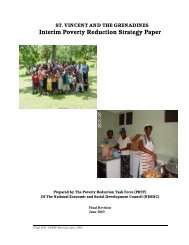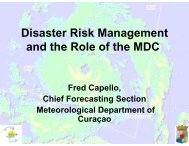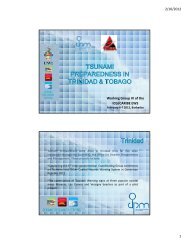The Anatomy of A Silent Crisis The Anatomy of A Silent Crisis
The Anatomy of A Silent Crisis The Anatomy of A Silent Crisis
The Anatomy of A Silent Crisis The Anatomy of A Silent Crisis
- TAGS
- anatomy
- www.bb.undp.org
Create successful ePaper yourself
Turn your PDF publications into a flip-book with our unique Google optimized e-Paper software.
74 Forum 2009: Climate Change – <strong>The</strong> <strong>Anatomy</strong> <strong>of</strong> a <strong>Silent</strong> <strong>Crisis</strong><br />
<strong>The</strong> link between adaptation, sustainable development and disaster risk<br />
reduction<br />
Integrating strategies — Mutually reinforcing versus mutually destructive<br />
<strong>The</strong>re are significant benefits to incorporating climate adaptation in development planning.<br />
When development programmes help build resilience and reduce vulnerability to climate change it<br />
reinforces the objectives <strong>of</strong> long term poverty reduction. For example, the government in the Pacific<br />
Ocean island <strong>of</strong> Kiribati has worked with donors to integrate climate change risk assessments <strong>of</strong><br />
sea level rise and storms into national planning, working through high-level ministerial committees. 245<br />
Such efforts are also urgently needed in the Himalayas where there is a close link between rising<br />
temperatures and the melting glaciers that increase the risk catastrophic flooding. Such floods are<br />
especially dangerous because they can occur with no advance warning. A range <strong>of</strong> development<br />
activities, from the design <strong>of</strong> hydropower facilities to an overhaul <strong>of</strong> rural development and settlement<br />
policies, are needed to adapt to such impacts. 245 In the area <strong>of</strong> rural development, agricultural<br />
planning and crop choice are critical to reduce vulnerability to climate change. In Africa over 90<br />
percent <strong>of</strong> farmers are small scale and about 65 percent246 <strong>of</strong> the population have agriculture as their<br />
primary source <strong>of</strong> income — a sector that is very vulnerable to climate change. 246<br />
“ I have seen, first hand, in growing numbers <strong>of</strong><br />
natural disasters the following bitter, heartbreaking<br />
reality: those who now struggle hardest to survive<br />
did nothing to cause climate change, whereas we in<br />
the industrialized North who polluted the most are<br />
affected the least. We have a moral obligation to make<br />
it right by investing massively in the survival <strong>of</strong> the<br />
most vulnerable”<br />
Jan Egeland — Director, Norwegian Institute <strong>of</strong> International Affairs; UN Under-Secretary-General<br />
for Humanitarian Affairs and Emergency Relief Coordinator (2003-2006)







